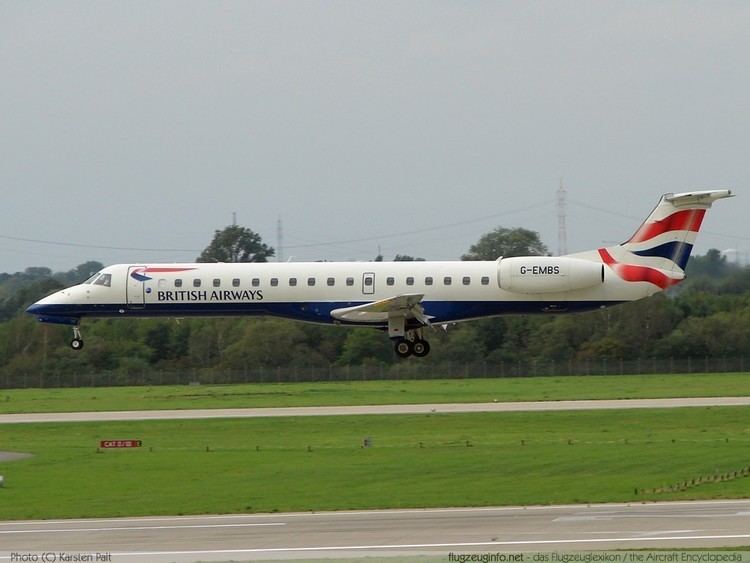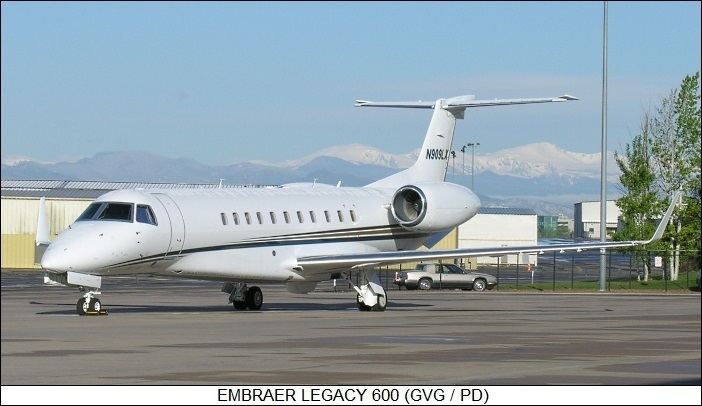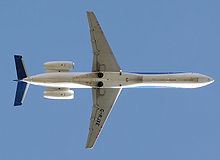Wingspan 20 m | Introduced 6 April 1997 | |
 | ||
Embraer 145 landing at klax rwy 25l cocpkit view
The Embraer ERJ 145 family is a series of twin-engine regional jets produced by Embraer, a Brazilian aerospace company. Family members include the ERJ 135 (37 passengers), ERJ 140 (44 passengers), and ERJ 145 (50 passengers), as well as the Legacy business jet and the R-99 family of military aircraft. The ERJ 145 is the largest of the group. Each jet in the series is powered by two turbofan engines. The family's primary competition comes from the Bombardier CRJ regional jets.
Contents
- Embraer 145 landing at klax rwy 25l cocpkit view
- N286hf intel air shuttle aircraft embraer erj 145xr to pdx
- Development
- Early design
- Interim design
- Production design
- Derivatives
- Production
- Engine
- Avionics
- Operations
- Civilian models
- Military models
- Civilian operators
- Military operators
- Notable accidents
- References

N286hf intel air shuttle aircraft embraer erj 145xr to pdx
Development

The ERJ-145 was designed for a perceived new market for regional jet aircraft, where the increased speed, comfort and passenger appeal would outweigh the inherent fuel economy of the turboprop aircraft which were in service and in development. In order to reduce the development cost, it used the EMB120 nose and the same fuselage cross-section.
Early design

The ERJ 145 was launched at the Paris Airshow in 1989 as a stretched and turbofan-powered modification of the EMB 120 Brasilia. Key components of this design included:
Interim design

By 1990, Embraer engineers found that results from wind-tunnel testing were less than satisfactory, and began considering a significantly different design from the EMB 120. The proposed modified design included a slightly (22.3°) swept wing with winglets, as well as engines mounted in underwing nacelles. This second design showed markedly better aerodynamic performance, but the combination of swept wings and wing-mounted engines required an unusually high (and therefore heavy) undercarriage.
Production design

The design evolved until late 1991, at which time it was frozen. Though the aircraft went through many alterations before it was finalized, it did retain a few of the original influences of the EMB 120 such as the three abreast seating (2+1) configuration which was a similar configuration used for the Embraer/FMA CBA 123 Vector design which never reached production. The key features of the production design included:

The first design was intended to retain as much commonality as possible with the EMB 120. However, the aircraft has sold well thus overcoming the initial setbacks. Embraer delivered 892 units of all variants through 2006, and predicted that another 102 units would be delivered in the 2007-2016 time period.
Derivatives
The ERJ 140 is based on the ERJ 145 with 96% parts commonality and the same crew type rating. The only significant changes are a shorter fuselage, a slightly derated engine and an increased range. At launch, Embraer estimated the cost of an ERJ 140 to be approximately US$15.2 million. The estimated cost of development of the ERJ 140 was US$45 million. The ERJ 135, with a service entry date of 1999, has 95% parts commonality with the ERJ 145, but is 11.7 feet (3.6 m) shorter.
The ERJ 145 seats 50 passengers, the ERJ 140 seats 44, and the ERJ 135 seats 37. The ERJ 140 was designed with fewer seats in order to meet the needs of some major United States airlines, which have an agreement with the pilots' union to limit the number of 50-seat aircraft that can be flown by their affiliates.
Production
In 2003, Embraer entered a partnership with the Harbin Aircraft Industry Group of Harbin, China. The resulting joint-venture company Harbin Embraer Aircraft Industry began producing the ERJ 145 for the Chinese market by assembling complete knock down kits prepared by other worldwide Embraer operations. After 13 years, its last delivery was done in March 2016; more than 40 ERJ-145 and 5 Embraer Legacy 650 were assembled.
Engine
The EMB-145 Family of aircraft generally come equipped with two Rolls-Royce AE 3007 series turbofan engines. The engines have a bypass ratio of 5:1. The engines are controlled by two FADECs (Full Authority Digital Engine Controls). The FADECs control virtually all aspects of the engine and send engine data to be displayed on the EICAS for the pilot.
Avionics
The Embraer ERJ 145 Family typically comes equipped with the Honeywell Primus 1000 Avionics suite. The suite normally consists of five CRT display units (DUs) or screens. From left to right, the system consists of a Primary Flight Display (PFD), Multi-Function Display (MFD), Engine Indication and Crew Alerting System (EICAS), Multi-Function Display (MFD) (Co-pilot) and Primary Flight Display (PFD) (Co-pilot). The DUs are normally CRTs but can be upgraded to lighter LCD displays. These upgraded DUs also have added functionality.
Operations
The first flight of the ERJ 145 occurred on August 11, 1995, with the first delivery in December 1996 to ExpressJet Airlines (then the regional division of Continental Airlines flying as Continental Express). ExpressJet is the largest operator of the ERJ 145, with 270 of the nearly-1,000 ERJ 145s in service. The second largest operator is Envoy Air, with 206 ERJ 145 aircraft. Trans States operates 47 ERJ 145s through alliances with United Express and Envoy Air. Chautauqua Airlines also operates 38 ERJ 145s through an alliance with Delta Connection.
By some accounts, the ERJ 145 has a cost of ownership of about $2,500,000 per year.
In March 2007 ExpressJet entered into a short-term agreement to operate some regional routes for JetBlue Airways using its ERJ 145 aircraft.
The ERJ 140 was introduced in September 1999, first flew on June 27, 2000 and entered commercial service in July 2001. Envoy Air, the regional jet subsidiary of American Airlines flying as American Eagle, operates the majority of the ERJ 140s built, including the first to be delivered (N800AE).
As of early 2005, 74 ERJ 140s had been delivered.
This version is marketed as ERJ 140, but on the company's internal documents and on Federal Aviation Administration certification, the version is designated EMB 135KL.
Civilian models
The physical engines are the same (Rolls-Royce AE 3007), however, the FADEC (Full Authority Digital Engine/Electronic Control) logic is what differs between the various models in regards to total thrust capability.
The extended range version, the ERJ 145ER, has Rolls Royce AE 3007A engines rated at 31.3 kN(7,036 lb) thrust, with the option of more powerful AE 3007A1 engines. A, A1, A1P models are mechanically identical but differ in thrust due to variations in FADEC software. The A1E engine, however, has not only new software, but significantly upgraded mechanical components.
The long-range ERJ 145LR aircraft is equipped with Rolls Royce AE 3007A1 engines which provide 15% more power. The engines are flat rated at 33.1 kN (7,440 lb) thrust to provide improved climb characteristics and improved cruise performance in high ambient temperatures.
The extra-long-range ERJ 145XR aircraft is equipped with Rolls-Royce AE 3007A1E engines. The high performance engines provide lower specific fuel consumption (SFC) and improved performance in hot and high conditions. The engines also yield a higher altitude for one-engine-inoperable conditions." CommutAir and ExpressJet are the only two operators of the ERJ 145XR. February 2011 Embraer presented its new EMB-145 AEW&C for India.
Despite the multiple variants, pilots need only one type rating to fly any variant of the ERJ aircraft. Companies like American Eagle and ExpressJet Airlines utilize this benefit with their mixed fleet of ERJ135ER/LR and ERJ145EP/LR/XR. Shared type ratings allows operators to utilize a single pilot pool for any ERJ aircraft.
Military models
Civilian operators
The main civilian operators, with ten units or more, on February 26, 2016 are:
Military operators
Notable accidents
The ERJ 145 family of aircraft has no reported crashes or fatalities due to mechanical malfunction in over 15 million hours (as of June 2009) of flight time for the fleet.
